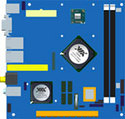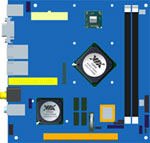Linux support a requirement in “Mini-ITX 2.0”
Jun 5, 2008 — by LinuxDevices Staff — from the LinuxDevices Archive — 6 views Via has updated its seven-year-old Mini-ITX specification, to better enable modern PC technologies like PCIe graphics cards, Blu-Ray disks, and SATA-II storage. The “Mini-ITX 2.0” standard adds a x16 (“by 16”) PCI Express lane and other requirements, some aimed at showcasing Via's newest chip-level products.
Via has updated its seven-year-old Mini-ITX specification, to better enable modern PC technologies like PCIe graphics cards, Blu-Ray disks, and SATA-II storage. The “Mini-ITX 2.0” standard adds a x16 (“by 16”) PCI Express lane and other requirements, some aimed at showcasing Via's newest chip-level products.
Via describes Mini-ITX 2.0 as an “open industry standard.” It retains the same compact 6.7-inch square (17 cm square) form-factor used in the original Mini-ITX spec, which debuted seven years ago. However, it adds a number of new feature and interface requirements, starting with a “high-performance, power efficient x86 processor, such as the Via Nano.” Via announced Nano only last week. The chip is the first to use Via's new “64-bit, superscalar, speculative out-of-order” Isaiah micro-architecture.


Via's Mini-ITX 2.0 mock-ups
(Click to enlarge)
Another Mini-ITX requirement is that integrated graphics processors (IGPs) must support DirectX 9.0, a set of media codecs defined by Microsoft. Naturally, Via just announced a chipset with just such an IGP — the VX800 and VX800U.
Further, DirectX 10 will be supported on Mini-ITX 2.0 via add-in PCI Express graphics cards, Via says. While today's PCIe video cards may not fit very well into Mini-ITX enclosures, Mini-ITX boards feature mounting-hole overlap with the FlexATA standard, allowing them to be used in most standard PC cases. And, Via says it is working with Nvidia, a leader in the external graphics card market, to “drive innovation and maximize freedom of choice.” It remains unclear, though, whether Mini-ITX 2.0 PCIe graphics cards will be scaled-down desktop-style expansion cards, or something similar to Nvidia's 2004 MXM graphics module standard for laptop video cards.
Other features and interfaces Via calls “minimum specifications” for Mini-ITX 2.0 boards include:
- Support for a minimum of 2GB DDR2 SDRAM
- VGA port for LCD display (HDMI via expansion card)
- HD Audio: 3 audio jacks for up to 6-channel surround sound
- 1 x gigabit LAN port
- 2 x serial ATA II slots + 1 x IDE (PATA) slot
- At least four USB 2.0 ports
- 1 x PCI Express 16-lane slot
Additionally, Via lists operating system requirements for Mini-ITX 2.0 as follows:
- Microsoft Windows Vista
- Microsoft Windows Vista Premium (with add-in graphics card)
- Microsoft Windows XP
- “Major Linux distributions such as Ubuntu, Suse Linux, and gOS”
Timothy Chen, special assistant to the president, stated, “We are paving the way for the emergence of a new generation of high performance systems [for] today's increasingly media rich environment.”
Drew Henry, GM of Nvidia's MCP business, stated, “VIA's new solution allows customers to play today's latest PC games and experience new video and photo applications available with Nvidia's DX10 GPUs.”
VIA originally launched Mini-ITX as a way to showcase its inexpensive chipsets for computer hobbyists, but the form factor has since gone into many other embedded markets. Its success has brought a vast proliferation of cases, power supplies, slim-line drives, Flash-to-IDE adapters, and other handy computing components that have helped drive the form factor into applications such as living room PCs and commodity hardware-based dense computing systems.
Additionally, the charms of Mini-ITX have not been lost on industrial board vendors such as Kontron and others. Of course, it's important to note that Mini-ITX motherboards from industrial single-board computer (SBC) vendors typically offer thicker PCBs, more rugged designs, and better build quality, compared with Mini-ITX boards aimed at the consumer market. They also have correspondingly higher prices and minimum order volumes.
Availability
Boards and systems based around the Mini-ITX 2.0 standard will be available from leading vendors in the fourth quarter of 2008, Via said.
This article was originally published on LinuxDevices.com and has been donated to the open source community by QuinStreet Inc. Please visit LinuxToday.com for up-to-date news and articles about Linux and open source.